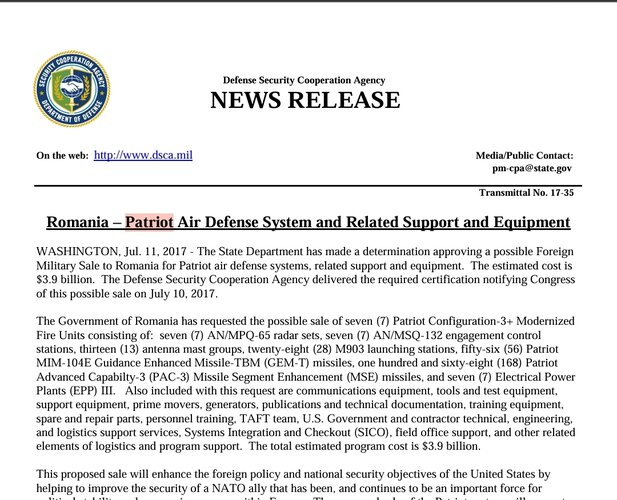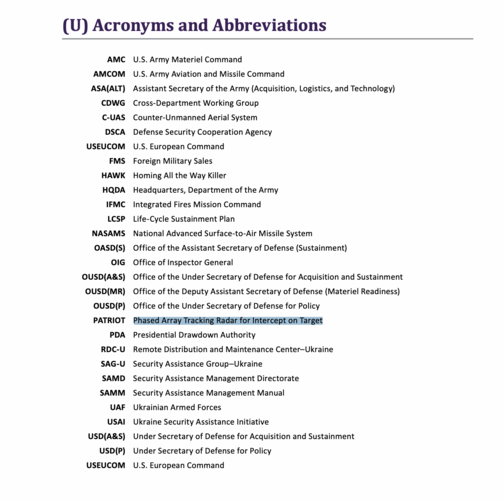Don't know what the Army is thinking of right about now, but one lesson from Ukraine that they've publicly spoken off is a quick emplacement/displacement and reload time. A vertical or near vertical launcher would also be nice as was considered an advantage based on the Army's last PATRIOT modernization AOA. You probably also want to have an integrated IFCN or RIG-360 antenna rather than a seperate equipment that is towed or carried on a different vehicle. Lots of things you can do if you considered a clean sheet launcher. But there seems to be no money for it. At a minimum the Army should look to integrate the MSE missile into the THAAD launcher, and the THAAD launcher into AIAMD. Not sure if that's a MDA or Army budget priority..
I can provide some additional insight a little later..
So you can displace faster once the enemy locates your TEL.
Though that leads me to a different and more interesting question: Given that most SAM radars are easily detectable and therefore easily located (and therefore easily destroyed), has anyone put any thought into L
Don't know what the Army is thinking of right about now, but one lesson from Ukraine that they've publicly spoken off is a quick emplacement/displacement and reload time. A vertical or near vertical launcher would also be nice as was considered an advantage based on the Army's last PATRIOT modernization AOA. You probably also want to have an integrated IFCN or RIG-360 antenna rather than a seperate equipment that is towed or carried on a different vehicle. Lots of things you can do if you considered a clean sheet launcher. But there seems to be no money for it. At a minimum the Army should look to integrate the MSE missile into the THAAD launcher, and the THAAD launcher into AIAMD. Not sure if that's a MDA or Army budget priority..
Ok, so I'm new here. I love learning and sharing a few things as I'm allowed.. I worked on the PAC-3 program for 6 years, HIMARS for 2 years and THAAD for past 3 years. I'm not looking to "own" anyone but will offer correctional insight when I can.
The reload time for US Army Patriot air defenders is about 1 hour. I can't speak for Ukraine or any other Allied Patriot AD.
That being said, it's not relevant because they're always defended by other launchers during reload.
A Patriot battery is linked via fiber optic cables, but can also be linked via wireless with lesser performance, hence the AMG.
A THAAD battery successfully integrated and test fired a PAC-3 MSE interceptor using a THAAD radar and fire control.
There is no Patriot replacement and/or overhaul. The Patriot air and missile defense battery is combat proven and seen as the gold standard around the world.
There is no requirement to alter the current configuration using the M860 trailers pulled by the M983 HEMTT nor is there any need. Germany has a truck mounted version though.
Also the Patriot isn't trying to hide. It wants to be fired at, but even so, the case that it needs to be more mobile to "shoot and scoot" is a misunderstanding about Patriot radar technology. It has an extremely narrow frequency hopping beam and is almost undetectable.
Lastly, please don't spell Patriot in all caps. It's not an acronym. It's called Patriot because the name sounds cool, not because someone was able to back into an official sounding technical acronym (backronym)
No warfighter, air defender, Raytheon, Lockheed Martin or the Program Office spells it in all caps.
Feel free to ask me anything. I'll answer what I can. If i don't know the answer I'll admit to it.
Don't know what the Army is thinking of right about now, but one lesson from Ukraine that they've publicly spoken off is a quick emplacement/displacement and reload time. A vertical or near vertical launcher would also be nice as was considered an advantage based on the Army's last PATRIOT modernization AOA. You probably also want to have an integrated IFCN or RIG-360 antenna rather than a seperate equipment that is towed or carried on a different vehicle. Lots of things you can do if you considered a clean sheet launcher. But there seems to be no money for it. At a minimum the Army should look to integrate the MSE missile into the THAAD launcher, and the THAAD launcher into AIAMD. Not sure if that's a MDA or Army budget priority..







